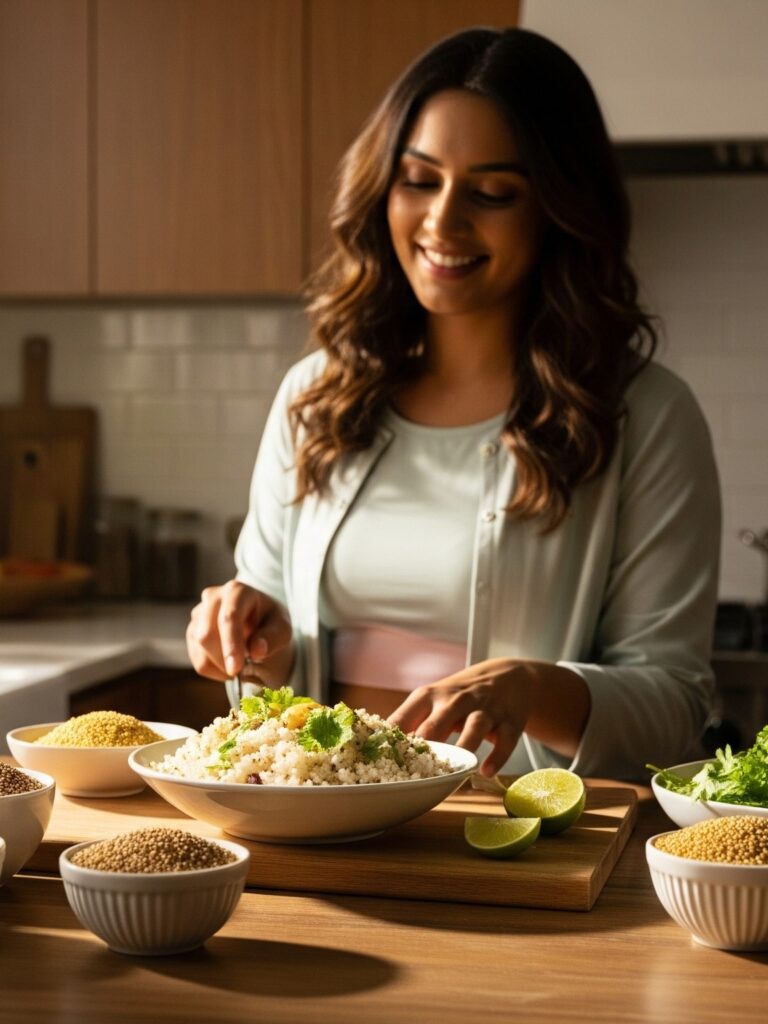India’s Rising Obesity and Joint Pain Crisis
Medically Reviewed By
Aditya Khurana (MD, MBBS)
In this blog
What is GLP-1 and how does it work?
Week-by-Week breakdown
Tips and lessons from real users
The EARLY Perspective
Conclusion
About the Author
References
Ready to lose weight for good?
Pain in your knees or back isn’t just an age thing anymore. More and more people in their 30s and 40s, especially in cities, are struggling with joint pain that makes daily life harder. One of the biggest hidden causes? Obesity.
Carrying extra weight doesn’t just show up on a weighing scale, it shows up in your joints, especially the knees and spine. Let’s break it down simply: what’s going wrong, why it’s happening more now, and how to fix it before it gets worse.
Why Are So Many People in India in Pain?
Joint and back pain are now among the top causes of disability in India, especially in urban areas. According to the Global Burden of Disease Study, knee osteoarthritis alone causes over 2.1 million years lived with disability (YLDs) in India. And back pain? It’s the leading cause of disability worldwide.
In cities, the problem is growing even faster due to:
- Sedentary lifestyles (sitting for long hours)
- Poor posture
- Lack of physical activity
- Rising obesity rates
How Obesity Affects Your Knees?
Your knees carry the weight of your body every time you walk, climb stairs, or even stand. When you’re overweight, that pressure increases dramatically.
Every extra 1 kg of body weight adds about 4 kg of pressure on your knees while walking.
So if you’re 10 kg overweight, your knees feel like they’re carrying an extra 40 kg all day. Over time, this leads to wear and tear of cartilage, a condition known as knee osteoarthritis.
Common signs of knee problems:
- Pain while walking or climbing stairs
- Stiffness, especially in the morning or after sitting
- Cracking or popping sounds in the knee
- Swelling or inflammation
Studies show Indian women over 40 are twice as likely to develop knee OA due to hormonal changes, lower muscle mass, and higher obesity rates in urban settings .
How Obesity Affects Your Back?
Your spine is designed to hold your body upright, but it’s sensitive to imbalance and excess weight. Fat, especially around the belly, pulls your spine forward, and this increases stress on your lower back.
Here’s what obesity can do to your spine:
- Increases pressure on spinal discs (the cushions between your vertebrae)
- Weakens core muscles, making your back work harder
- Leads to poor posture, which worsens back pain
- Can cause herniated discs, sciatica, and chronic low back pain.
Back pain linked to weight isn’t just short-term discomfort. It can become chronic and even lead to mobility issues if left untreated.
Knee and Back Pain Often Go Hand-in-Hand
Pain in the knees can change how you walk, which puts more strain on your lower back. Likewise, back pain can limit movement, leading to muscle weakness, stiffness, and even more weight gain creating a vicious cycle. “When you gain weight, your pain gets worse. When you’re in pain, you move less. When you move less, you gain more weight.”
Why Urban India Is at Higher Risk
Urban lifestyles are a perfect storm:
- Desk jobs = long sitting hours
- Elevators instead of stairs
- Easy food delivery = poor diets
- Lack of open spaces = less walking
According to the National Family Health Survey (NFHS-5), over 24% of urban Indian adults are overweight or obese, and the number is rising every year [6]. With weight gain comes an explosion of joint and spine issues, even in young adults.
Who is eligible to use GLP-1 medication for weight loss?
The good news? Even a small weight loss can make a big difference in relieving pain.
- Lose just 5-10% of your body weight
This can reduce pressure on your knees, improve spine health, and reduce inflammation. - Walk daily (even if it’s slow)
Low-impact movement like walking helps strengthen muscles and improve blood flow. If walking hurts, consider swimming or cycling. - Eat anti-inflammatory foods
Focus on:
High-protein foods (to build joint-supporting muscles)
Omega-3 fats (found in flaxseeds, walnuts, and fatty fish)
Vegetables and fruits (rich in antioxidants) - Build strength, not just lose weight
Stronger thigh, core, and back muscles help support your joints. Bodyweight exercises like wall sits, planks, and glute bridges are a great start. - Check your posture
Poor posture adds pressure to your back and knees. Use a footrest when sitting, avoid slouching, and get up every 30–45 minutes. - Track your metabolic health
Sometimes, weight gain is driven by underlying metabolic issues—like insulin resistance, thyroid imbalance, or PCOS. Getting a metabolic score test can help identify hidden reasons behind joint pain and obesity.
Joint and back pain are now among the top causes of disability in India, especially in urban areas. According to the Global Burden of Disease Study, knee osteoarthritis alone causes over 2.1 million years lived with disability (YLDs) in India. And back pain? It’s the leading cause of disability worldwide.
In cities, the problem is growing even faster due to:
- Sedentary lifestyles (sitting for long hours)
- Poor posture
- Lack of physical activity
- Rising obesity rates
How Obesity Affects Your Knees?
Your knees carry the weight of your body every time you walk, climb stairs, or even stand. When you’re overweight, that pressure increases dramatically.
Every extra 1 kg of body weight adds about 4 kg of pressure on your knees while walking.
So if you’re 10 kg overweight, your knees feel like they’re carrying an extra 40 kg all day. Over time, this leads to wear and tear of cartilage, a condition known as knee osteoarthritis.
Common signs of knee problems:
- Pain while walking or climbing stairs
- Stiffness, especially in the morning or after sitting
- Cracking or popping sounds in the knee
- Swelling or inflammation
Studies show Indian women over 40 are twice as likely to develop knee OA due to hormonal changes, lower muscle mass, and higher obesity rates in urban settings .
How Obesity Affects Your Back?
Your spine is designed to hold your body upright, but it’s sensitive to imbalance and excess weight. Fat, especially around the belly, pulls your spine forward, and this increases stress on your lower back.
Here’s what obesity can do to your spine:
- Increases pressure on spinal discs (the cushions between your vertebrae)
- Weakens core muscles, making your back work harder
- Leads to poor posture, which worsens back pain
- Can cause herniated discs, sciatica, and chronic low back pain.
Back pain linked to weight isn’t just short-term discomfort. It can become chronic and even lead to mobility issues if left untreated.
Knee and Back Pain Often Go Hand-in-Hand
Pain in the knees can change how you walk, which puts more strain on your lower back. Likewise, back pain can limit movement, leading to muscle weakness, stiffness, and even more weight gain creating a vicious cycle. “When you gain weight, your pain gets worse. When you’re in pain, you move less. When you move less, you gain more weight.”
Why Urban India Is at Higher Risk
Urban lifestyles are a perfect storm:
- Desk jobs = long sitting hours
- Elevators instead of stairs
- Easy food delivery = poor diets
- Lack of open spaces = less walking
According to the National Family Health Survey (NFHS-5), over 24% of urban Indian adults are overweight or obese, and the number is rising every year [6]. With weight gain comes an explosion of joint and spine issues, even in young adults.
Who is eligible to use GLP-1 medication for weight loss?
The good news? Even a small weight loss can make a big difference in relieving pain.
- Lose just 5-10% of your body weight
This can reduce pressure on your knees, improve spine health, and reduce inflammation. - Walk daily (even if it’s slow)
Low-impact movement like walking helps strengthen muscles and improve blood flow. If walking hurts, consider swimming or cycling. - Eat anti-inflammatory foods
Focus on:
High-protein foods (to build joint-supporting muscles)
Omega-3 fats (found in flaxseeds, walnuts, and fatty fish)
Vegetables and fruits (rich in antioxidants) - Build strength, not just lose weight
Stronger thigh, core, and back muscles help support your joints. Bodyweight exercises like wall sits, planks, and glute bridges are a great start. - Check your posture
Poor posture adds pressure to your back and knees. Use a footrest when sitting, avoid slouching, and get up every 30–45 minutes. - Track your metabolic health
Sometimes, weight gain is driven by underlying metabolic issues—like insulin resistance, thyroid imbalance, or PCOS. Getting a metabolic score test can help identify hidden reasons behind joint pain and obesity.
When Should You See a Doctor?
If your knee or back pain:
- Lasts more than 2–3 weeks
- Gets worse with time
- Affects your sleep
- Limits your daily movement
…it’s time to consult a specialist. You may need X-rays, physical therapy, or in some cases, medical weight loss options like GLP-1-based treatments. GLP_1 treatments should only be taken under medical supervision and only if you are found to be eligible by a doctor.
Final Thoughts: Don’t Ignore the Pain
Knee and back pain may feel like “normal” signs of aging or busy city life—but they’re not. They are red flags from your body. Ignoring them can lead to permanent joint damage, mobility loss, and more serious health problems.
Small changes—like walking a little more, eating better, and losing just a few kilos—can reduce pain and protect your joints for the long run.

About the Author
Wrishila Pal
Wrishila leads marketing at Early, bringing over 5 years of writing experience across brand, performance, and product. A published author who began her journey in storytelling, she’s built content engines, scaled narratives across industries, and believes great writing balances clarity, emotion, and impact, especially when it comes to health.
References
- Vos T, et al. (2020)
https://doi.org/10.1016/S0140-6736(20)30925-9 - Hoy D, et al. (2014)
https://ard.bmj.com/content/73/6/968 - Messier SP, et al. (2005).
https://onlinelibrary.wiley.com/doi/10.1002/art.21342 - Pal CP, et al. (2016).
https://www.sciencedirect.com/science/article/pii/S0976566215001078 - Shiri R, et al. (2010).
https://academic.oup.com/aje/article/171/2/135/135233 - NFHS-5 (2021). http://rchiips.org/nfhs/NFHS-5_FCTS/India.pdf
In this blog
Why Are So Many People in India in Pain?
How Obesity Affects Your Knees?
How Obesity Affects Your Back?
Knee and Back Pain Often Go Hand-in-Hand
Why Urban India Is at Higher Risk
What You Can Do (Even If You’re Already in Pain)
When Should You See a Doctor?
Final Thoughts: Don’t Ignore the Pain




